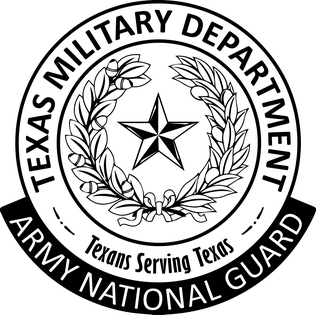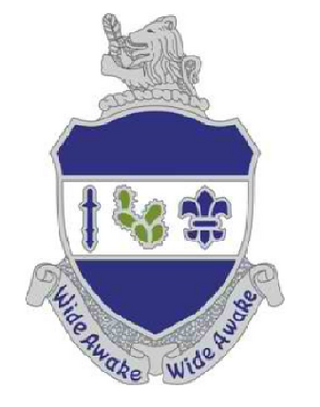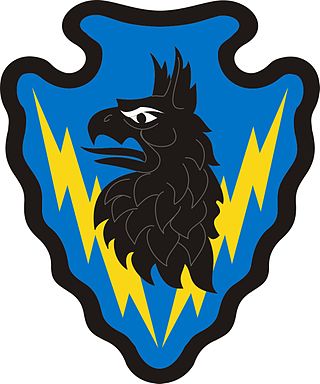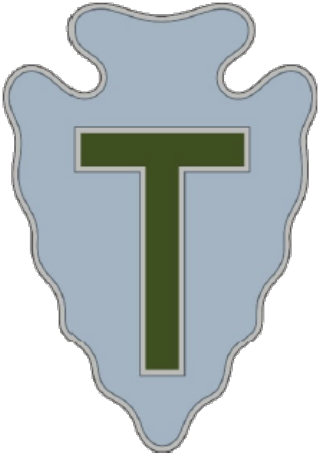Related Research Articles

The 36th Infantry Division ("Arrowhead") also known as the "Panther Division", the "Lone Star Division", "The Texas Army", and the "T-patchers", is an infantry division of the U.S. Army and part of the Texas Army National Guard. The 36th Infantry Division was organized during World War I (1914–1918) from units of the Texas National Guard and of the Oklahoma National Guard. As an all-Texas unit, the Arrowhead Division was called to service for World War II (1937–1945) on 25 November 1940, was deployed to the European Theater of Operations in April 1943, and returned to the Texas Army National Guard in December 1945.

The Army National Guard (ARNG), in conjunction with the Air National Guard, is an organized militia force and a federal military reserve force of the United States Army. They are simultaneously part of two different organizations: the ARNG of each state, most territories, and the District of Columbia, as well as the federal ARNG, as part of the National Guard as a whole. It is divided into subordinate units stationed in each state or insular area, responsible to their respective governors or other head-of-government.

The United States Army Rangers are U.S. Army personnel who have served in any unit which has held the official designation of "Ranger". The term is commonly used to include graduates of the Ranger School, even if they have never served in a "Ranger" unit; the vast majority of Ranger school graduates never serve in Ranger units and are considered "Ranger qualified".

A long-range reconnaissance patrol, or LRRP, is a small, well-armed reconnaissance team that patrols deep in enemy-held territory.
Reconnaissance, surveillance, and target acquisition (RSTA) groups the tasks of reconnaissance, surveillance and target acquisition conducted by the Department of Defense. RSTA supports military operations at a strategic, operational, or tactical level, either by dedicated RSTA forces or those which possess the capability.

The 58th Expeditionary Military Intelligence Brigade is a military intelligence brigade of the United States Army National Guard in Maryland. It was largely formed from the personnel and equipment of the 58th Battlefield Surveillance Brigade and officially stood up in its present configuration on 1 August 2015. Most recently, members of the brigade joined state efforts to contain the spread of COVID-19 in Maryland and constituted one of the last U.S. Army National Guard units to serve in the War in Afghanistan, returning to Maryland in February, 2021.

The 50th Armored Division was a division of the Army National Guard from July 1946 until 1993.

The Texas Army National Guard is a component of the United States Army, the United States National Guard and the Texas Military Forces.
The 75th Infantry Regiment (Ranger) (officially 75th Infantry Regiment or 75th Infantry) was initially a parent regiment for all the US Army Ranger units during the Vietnam War and the early 1980s and then the headquarters for the Ranger battalions.

The 143rd Infantry Regiment is an airborne infantry formation in the Army National Guard and has one battalion active under the Texas Army National Guard.

The 133rd Field Artillery Regiment is a parent field artillery regiment of the United States Army National Guard. It is currently represented in the Texas Army National Guard by the 1st, 3rd, and 4th Battalions.

The 51st Infantry Regiment is a regiment of the United States Army first established in 1917.

The 58th Infantry Regiment is a regiment of the United States Army first established in 1917.

The 151st Infantry Regiment is an infantry unit in the Indiana National Guard, part of the 76th Infantry Brigade Combat Team (Separate).

The 71st Expeditionary Military Intelligence Brigade (EMIB) is a unit of the Texas Army National Guard.

The 56th Infantry Brigade Combat Team is a brigade combat team unit of the Texas Army National Guard, part of the 36th Infantry Division.

The 72nd Infantry Brigade Combat Team is a unit of the Texas Army National Guard and is subordinate to the 36th Infantry Division.

The 36th Airborne Brigade was an airborne brigade of the United States Army and the Texas Army National Guard. The brigade was active from 1 November 1973 to 1 April 1980. The unit's lineage continues today in the 36th Infantry Division.
References
- ↑ "Texas National Guard Reorganization Goes Into Effect Friday; Units Listed". Amarillo Globe Times. December 12, 1967. p. 8.
- ↑ "National Guard New Look". Muncie Evenng Press. December 2, 1967. p. 10.
- ↑ "Guard to Have Six New Units". The Daily Reporter. December 2, 1967. p. 1.
- ↑ Martino, Sam (December 13, 1967). "Guard Set To Realign In January". Lansing State Journal. pp. A3, A4.
- 1 2 Rottman, Gordon L. (1990). US Army Airborne 1940-1990. Osprey Publishing. p49.
- ↑ Aumiller, Timothy S. "United States Army Infantry, Artillery, Armor/Cavalry Battalions, 1957-2011" p31, from
- ↑ "Post World War II Texas National Guard".
- ↑ "Guard Disbands Brigade". The Victoria Advocate. April 12, 1980. pp. 7A.
- ↑ Faulkner, Michael (September 23, 2001). "Co. G 143rd Infantry (LRS)". Unofficial Unit Page for Co. G 143d Infantry (LRS). Archived from the original on December 21, 2001.
- ↑ Jacobs, Janet (August 13, 2001). "Paratroopers mark retirement on unit with one last jump". Austin American~Statesman. pp. B1. Archived from the original on February 16, 2024.
- ↑ Lemmer, Paul (August 18, 2001). "The Houston Light Guard: A Narritive". Co G. 143rd LRS. Archived from the original on October 22, 2002.
- ↑ "Post World War II Texas National Guard".